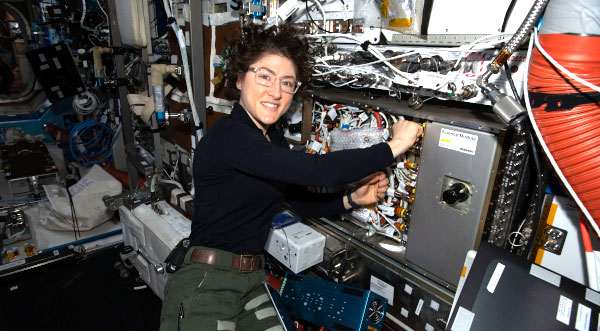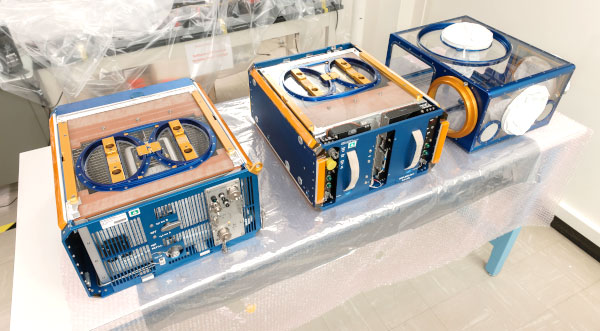Lessons Learned in 2020 from NASA, International Space Station Science Experiments and Research
By NASA // December 29, 2020
nasa & space news

(NASA) – Dozens of experiments are going on at any given time aboard the International Space Station. Research conducted in 2020 is advancing our understanding in areas of study from Parkinson’s disease to combustion.
Space station research results published this year came from experiments performed and data collected during the past 20 years of continuous human habitation aboard the orbiting laboratory. Between October 1, 2019, and October 1, 2020, the station’s Program Research Office identified more than 300 scientific publications based on space station research.
Here are the highlights of what we learned this year about groundbreaking space station science:
Small-scale drug delivery
The Italian Space Agency’s Nanoparticles and Osteoporosis (NATO) project studied a type of nanoparticle made of minerals similar to those found in bones and teeth, which could help counteract bone density loss.
The results showed that the new drug delivery system has beneficial effects on promoting stem cells to become osteoblasts – the cells responsible for bone formation.
Scientists could use this research to develop treatments to combat bone degeneration during long-duration spaceflight, or even for treating osteoporosis on Earth.
Diagnosing a long-standing spaceflight question
From the first return to Earth of humans who had been in space, researchers identified the astronauts experienced space anemia.
Anemia is a condition that results when there are not enough red blood cells to carry needed oxygen throughout the body.
Using more than five decades of astronaut data, the Canadian Space Agency MARROW investigation revealed that space anemia occurs after landing when the reverse shift of fluids related to gravity changes is completed.

The study demonstrated that over the time periods observed, astronauts lose red blood cells proportional to the time spent in space, and the recovery from space anemia takes between one and three months, depending on mission duration.
Additional research will need to be conducted to see if this trend continues over missions of longer duration.
Another publication from the MARROW study described methods to measure markers of human red blood cell destruction in extreme environments.
The elimination of carbon monoxide produced in the body measured with a parts-per-billion precision served as a reliable marker of red blood cell destruction.
Force feedback makes a difference
The study required astronauts to perform two tasks: an action requiring rapid aimed robot motions, and a task requiring minimal surface contact when moving the robot along a curved structure.
Results indicated that microgravity had an impact on motion control after six weeks. Scientists emphasized that force feedback is indispensable for space teleoperation missions.
Researchers recommend the continued examination of teleoperations from space using larger samples in different mission phases and with a more extensive variety of tasks.
Investigating Parkinson’s and Alzheimer’s disease
The results published in 2020 revealed two morphologies of fibrils in microgravity were more twisted and with a higher pitch than ground control samples.
This could help us learn more about how twists in neurodegenerative diseases form.
The two morphologies observed in microgravity were practically indistinguishable from one another, but grew much more slowly than those on Earth.
The microgravity fibrils also grew slower than fibrils on Earth, showing the space station is an ideal environment for detailed investigations examining the mechanisms of amyloid formation.
These promising findings could assist the development of new pharmaceuticals aimed at inhibiting amyloid fibril formation to prevent or treat neurodegenerative conditions.
Testing a technique to limit muscle loss

In a recent publication from the Rodent Research-3-Eli Lilly study sponsored by pharmaceutical company Eli Lilly and Co. and ISS US. National Lab, researchers described results of their study about whether the inhibition of myostatin through the delivery of an antibody could prevent the expected loss of skeletal muscle mass in a space environment.
Mice were treated with the antibody one day before launching to the space station and at two and four weeks in space.
At different times, grip strength and body composition of the mice were measured. The mice were frozen in space and then studied further back on Earth.
Findings showed the treatment with myostatin prevented almost all losses in lean mass, grip strength, and muscle weights induced by microgravity.
Mice treated with the antibody also prevented heart weight loss.
This research demonstrates that myostatin inhibition is an effective countermeasure to prevent muscle loss produced by the harsh environment of space.
However, the myostatin inhibition did not prevent bone loss, although it also did not have a detrimental effect on bone mineral density.
Unraveling the mysteries of lightning
In a newly published study, researchers used data ASIM obtained to show that TLEs and TGFs are related.
The experiment’s high-speed instruments helped researchers to determine the sequence of events that produces TGFs.

These studies are helping scientists better understand how thunderstorms affect Earth’s atmosphere.
Researchers used ASTERIA for observations and data collection of an exoplanetary system called 55 Cancri. The analyses revealed the exoplanet 55 Cancri e, a known transiting super-Earth orbiting a Sun-like star.
The resulting data of the transit search demonstrated that a signal can be seen in ASTERIA data, but not at a level that is significant enough to claim independent detection without prior knowledge of the planet’s orbit and transit.
However, ASTERIA demonstrates that an inexpensive spacecraft designed with an adaptable model of science in mind can deliver groundbreaking results.
Keeping things chill
Twenty-five years ago, scientists on Earth first produced the fifth state of matter with properties unlike solids, liquids, gases, and plasmas.
The achievement garnered a Nobel Prize for those scientists and changed the field of physics that builds on that legacy.
In 2018, NASA’s Cold Atom Lab became the first facility to produce that fifth state of matter, called a Bose-Einstein Condensate (BEC), in Earth’s orbit.
Chilling atoms is the only way to produce a BEC, so the Cold Atom Lab lowers atoms to ultracold temperatures to study their properties in ways not possible on Earth.
In a study published in the journal Nature this year, the research team reported on the details of getting this unique lab up and running, as well as their progress toward the long-term goal of using microgravity to illuminate new features of the quantum world.
BECs serve as a valuable tool for scientists studying quantum physics.
BECs collectively exhibit properties typically displayed only by individual atoms, making those microscopic characteristics visible at a much larger scale.
A microbial fingerprint on the space station
Results published from the NASA Microbial Tracking-2 study show that the microorganisms living on surfaces inside the space station so closely resembled those on an astronaut’s skin that scientists could tell when each new crew member arrived and departed by looking at the microbes left behind.
The findings show how keeping an eye on the tiniest space station residents is important for protecting the health of astronauts and the spacecraft they occupy.
It could even tell us something about relatively closed environments on Earth, like hospitals, where understanding the presence of microbes is key.
Learn more about the International Space Station results from this past year in our Annual Highlights of Results. You can also check out what we learned from the space station in 2019.
Keep up with current research by following @ISS_Research, Space Station Research, and Technology News or our Facebook.














